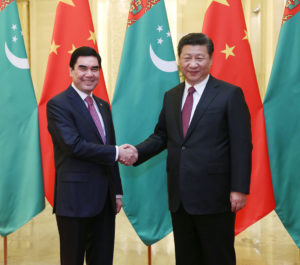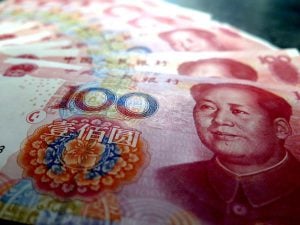China’s 14th five-year plan has evoked a significant amount of interest in Turkmenistan. The plan targets a significant lowering of carbon dioxide emissions and energy intensity. This may have both positive and negative implications for Turkmenistan. While the Central Asian country has emphasised a green transition in the past, its economy is deeply interlinked with fossil fuels. For example, more than 90% of its total exports are natural gas exports to China. This is a change from 13 years ago, when Russia was the main importer.
Since China’s plan was announced, Turkmenistan has been courting international bodies on matters of sustainable development. However, China’s continuing demand for natural gas may mean that there is weak incentive for deep change. The nudge towards a green transition is still an important development for Turkmenistan.
China’s 14th five-year plan heralds a green transition
On 13 March, 2021, China’s National People’s Congress approved the outline of the country’s 14th Five-Year Plan, covering the period 2021-2025. It sets out targets of an 18% reduction for CO2 intensity and 13.5% for energy intensity. It also introduces a longer-term goal of a CO2 emissions cap, but without a specific target.
This is a major shift in China’s thinking. According to the Oxford Energy Institute, it is the first time China has considered energy security and set a timeframe for reducing its coal power. It is the biggest climate commitment made by any nation, and embraces the goal of a much greener energy sector.
Impact of the pandemic on China and Turkmenistan
The impact of Covid-19 on the fossil fuel sector has added an impetus towards an energy transition. Lack of demand for transport fuels due to the pandemic created massive shocks to the market. According to the EY Oil and Gas Digital Transformation and the Workforce Survey 2020, oil and gas executives do not expect the market to ever return to its previous state. Disruptions will be here for some time, seriously affecting those countries heavily dependent on hydrocarbons. Consequently, Asian gas markets are re-examining the role of gas in the transition to clean energy, and intensifying support for the global energy agenda.
For Turkmenistan, China is the biggest concern. In March 2020, China issued a force majeure notice to halt supplies. According to Kazakhstan-based journalist Chris Rickleton, “the value of imports from Turkmenistan – which comprise almost exclusively natural gas – shrank by 30% in dollar terms … compared to 2019”. Despite this, Turkmenistan still sees China as a trustworthy partner. This relationship means it will take China’s focus on climate change seriously.
Renewable energy is not new to Turkmenistan
China’s actions, and the effects of the pandemic, are reinvigorating an older conversation on renewables in Turkmenistan. In 1979, the Turkmen SSR Academy of Sciences created the Solar Energy Institute (SOLNTSE), developing devices to meet small-scale energy needs. Former President Saparmurat Niyazov stated in 2006 that he “would like to see a wind turbine for every home”. He wanted Turkmenistan to be carbon neutral. But thus far this awareness has not been put into practice. If Chinese business practices in Turkmenistan reflect the 14th Five Year plan, this may push this agenda further.
Traditionally, external powers have little agency in Turkmenistan’s policy decisions. Their engagement is limited to neutral issues like climate change. However, China is the one country that could steer Turkmenistan towards renewable energy and green growth. David Hone, chief climate change adviser at Shell, states: “China has demonstrated time and again over the last 20 years that it can muster enormous capacity for change and implement big infrastructural projects.”
Turkmenistan’s diplomacy goes green
Turkmenistan is already stepping up its green energy diplomacy. Turkmenistan has been a member of the International Renewable Energy Agency (IRENA) since October 2018. It also recognises the appeal renewable energy has for western investors. Berdiniyaz Matiyev, Turkmenistan’s deputy foreign minister, met the director-general of IRENA in March 2021 to discuss cooperation in the use of renewable and alternative energy sources. State-controlled media in Turkmenistan have emphasised the country’s great potential for renewable energy, its attractiveness to green investors, and how it complements China’s new energy policy. This spring, Turkmenistan also participated in a roundtable dedicated to the upcoming United Nations Climate Change Conference. And it engaged in a sustainable energy-themed video conference with the British Embassy in Turkmenistan and PricewaterhouseCoopers (PwC).
Turkmenistan possesses huge potential for wind and solar energy, but the richness of gas and oil deposits mean that renewables have thus far not been a development priority. There are signs that this is changing, however, as in his annual address in February 2021, President Gurbanguly Berdimuhamedov stressed that “the ecological situation in the region and on the planet is of utmost concern”. He then underlined the need to review the law on renewable energy sources. Further proposals such as updating the State Program for Energy Saving for 2018-2024, the Program for the Development of Energy Diplomacy of Turkmenistan for 2021-2025, and the National Strategy for the Development of Renewable Energy in Turkmenistan until 2030 were adopted.
All of this is happening while Turkmenistan also hopes to increase its exports of natural gas and liquified natural gas (LNG). But given that 66% of China’s gas imports are already LNG, this is a bit of a gamble.
According to Stephen O’Sullivan, senior visiting research fellow at the Oxford Institute for Energy, Beijing has two options: use less gas in the energy mix, or build another pipeline. China does have plans to use more renewables and nuclear power, reducing dependency on gas, but, “China’s energy needs are so large that they will require more of every sort of energy – gas, nuclear, renewables… so it may not be a choice of “either/or” but of “all forms of energy.”
A new era for Turkmenistan’s green transition?
The journey to green energy has been moving at a glacial speed for decades in Turkmenistan. Whether China ultimately puts clean energy on a faster track than before, though, depends to a large extent on the choices political leaders make now. The Oil and Gas of Turkmenistan international conference that took place in Ashgabat in May displayed that foreign governments are interested. Baroness Nicholson of Winterbourne, the United Kingdom’s trade envoy to Turkmenistan said,:“With its vast solar and wind energy resources, Turkmenistan has great potential in producing renewable energy and reducing its carbon footprint.”
Qian Naicheng, the Chinese ambassador, added: “China is ready to take advantage of the opportunities for comprehensive expansion of cooperation, giving it new impetus.”
The question is whether this will be followed up by concrete actions. The government is certainly saying the right things of late. At the UN Global Roundtable on ‘Extractive Industries as Engines of Sustainable Development’ on 25 May 2021, the President Berdimuhamedov said that the country will “start developing a UN Strategy aimed at implementing measures to develop low-carbon energy”. He also announced “the creation, under the auspices of the UN, of an international ‘Road Map’ for the development of hydrogen as one of the priority directions in the energy sector”.
This, combined with the Conference on Science, Technology and Development of Innovative Technologies in Ashgabat in June, means that 2021 is shaping up to be a pivotal moment for renewables in Turkmenistan.









